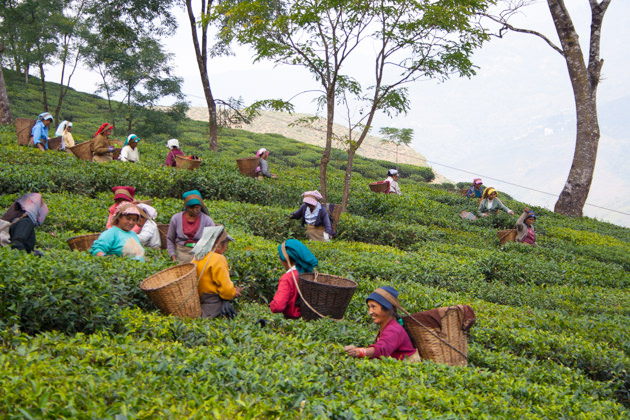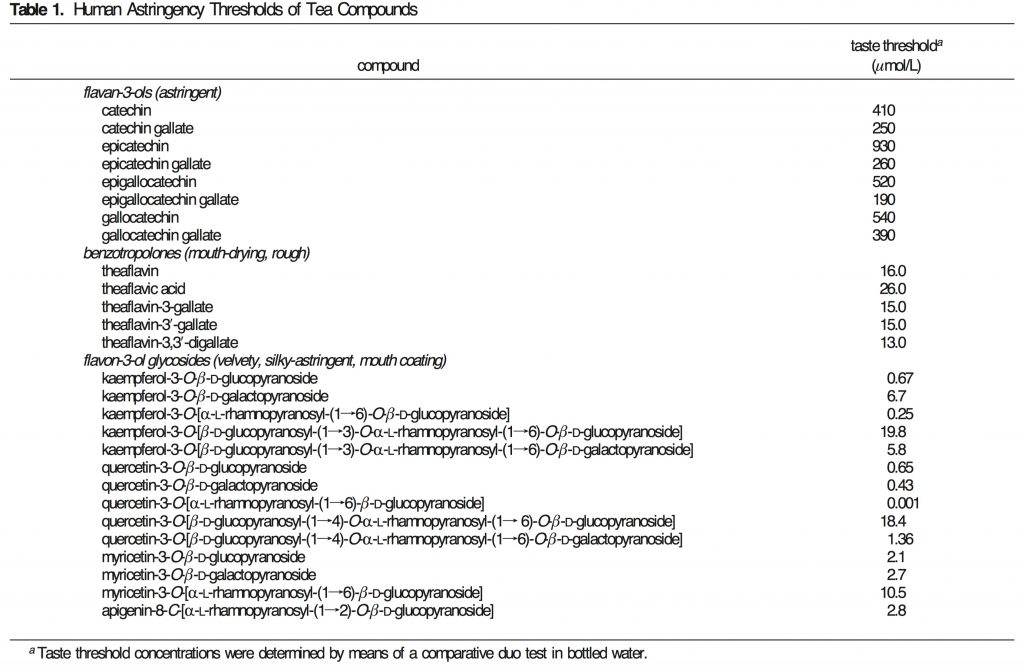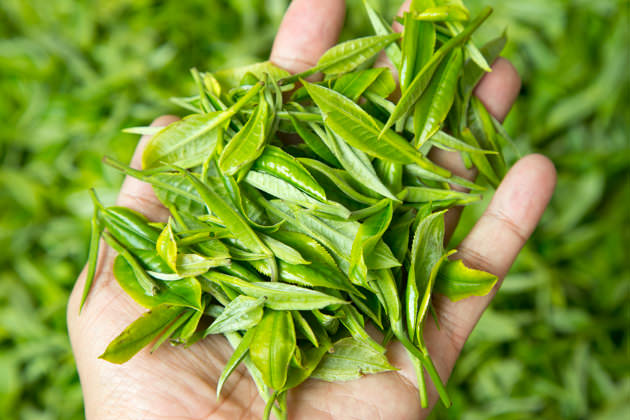- HOME >
- How to choose quality tea
The true reason why some pu-erh and black tea causes stomachache

We noticed that there are a number of customers who refrain from black tea or raw pu-erh tea due to the uncomforted stomach. I too have had the same experience that I suffered from stomachache after drinking some black tea. However, it has nothing to do with black tea or raw pu-erh tea. If tea is not made of the right material, any type of tea will give the same uncomfortable effect. Nevertheless, if tea is made from the right material, we can feel free to enjoy any type of tea even when empty stomach.
It is summer tea that causes various problems
Based on our experience, the summer tea has strong astringency which tends to cause stomachache.
During warm season especially in summer, one type of specific substance is composed in tea. When this type of tealeaf is processed into any type of tea, it tastes very astringent and causes stomachache. Because of the same reason, Darjeeling Second Flush gives strong astringency too. If the tea is processed into ripe pu-erh tea or deeply roasted oolong, the astringency is neglectable.
I have experienced the same trend in natural herbs. In Japan, I often go to the mountain to collect natural herbs. In spring, those herbs give sweetish taste and very thick flavor. These herbs are available in summer too. However, it turns extremely bitter and astringent in summer. It is impossible to enjoy them in summer.
For making black tea or raw pu-erh tea, the best quality is the first spring crop. Usually the first spring crop gives very sweet taste with creamy and soft mouth-feel. It is absolutely not astringent. However, the black tea and raw pu-erh tea is often made of the late-plucked tea in summer. The taste of the second- and third-plucked tea is less creamy and not soft but it is still acceptable. After the forth-plucked tea onwards, tea has a noticeable level of astringency.
In China, the price for the first-plucked tea is twice as expensive as the second-plucked tea. The price of third- or forth-plucked tea is much lower. The first-plucked spring tea is very limited due to the high demand. In the famous tea production area, the tea plucking is carried out more than 10 times. That means there is less than 10% of chance for getting the first-plucked spring tea. Considering that the first-plucked tea has high demand in China, most of the black tea or raw pu-erh tea available in overseas is the late-plucked tea. That is the reason why many people have negative experience with black tea and raw pu-erh tea. If the tea is of the first spring crop, it gives no astringency at all and the effect to the stomach is very gentle, no matter how thick we brew tea or drinking even when stomach is empty.
The root cause of the astringency
Now the question is what substance in tea causes stomachache and astringency. We should be able to identify it if we investigate which substance is particularly increasing in summer tea. I found the data in the Japanese book “Science of Tea” written by Yamanishi, on page 22. It shows that towards summer Epigallocatechin gallate (EGCg) is particularly increasing.
They monitored 4 different types of tea. No.1 from the left is Yabukita cultivar, No.2 is Qing-xin-wu-long, No.3 is Benihomare cultivar and the last one is Assam variety from Sri Lanka. 春 means spring and 夏 means summer.
Another literature, B Schwarz, T Hofmann – European Food Research and Technology, October 2008, 227explains in the abstract that Epigallocatechin gallate has a strong binding ability with protein.
Susanne Scharbert , Nadine Holzmann , and Thomas Hofmann, J. Agric. Food Chem., 2004, 52 (11), pp 3498–3508 carried out the sensory study to identify the substance in tea that causes astringency. The table below indicates the taste threshold to various poly phenols. The data shows that Epigallocatechin gallate gives the strongest astringent effect. Based on the data, we should be able to conclude that Epigallocatechin gallate is the substance causing the astringency and stomachache.
The mechanism that EGCg causes the astringency
Our oral and stomach cavity is made of protein. If any substance is binding with this protein layer, it gives astringent taste and uncomforted feeling. Tea with milk gives least effect in astringency and to the stomach, because Epigallocatechin gallate has already been reacted by milk protein and it is no longer reactive.
As a conclusion, the astringency or uncomfortable feeling with the stomach has nothing to do with the process or type of tea but it is directly affected by the material. If those teas are made of the first-plucked spring tea, we will not experience any astringent taste or stomachache at all.
In HOJO’s black tea and pu-erh tea lineup, all teas are made of the first spring crop except some Darjeeling autumn tea and second flush tea.
Every year we constantly visit the tea production sites to select tea in order to make sure that teas is mellow and not astringent.
Related Articles
How to get the latest update on HOJO Tea?
1. Follow Twitter, 2. Click "Like" on Facebook, and 3. Subscribe in newsletter. You can have the latest tea news from HOJO Tea.
 Subscribe the Newsletter to enjoy the privileges
Subscribe the Newsletter to enjoy the privileges- You may receive a free sample upon purchase, or you may have the priority to purchase special products. So please remember to subscribe our newsletter as well as the social network.
- New Release of High Mountain White Tea
- We are pleased to introduce our High Mountain White Tea, sourced from a unique tea garden with two key features: 1. Located at an altitude of 2200-2300m2. Completely wild and untended The ideal natural conditions of this garden result in tea of exceptional quality, offering a pure and gentle, nourishing taste. High Altitude and Wild …
- New Release of Da Xue Shan Wild White Tea 2024
- We have released the 2024 Da Xue Shan Wild White Tea Loose Leaf. This tea was produced under our direct supervision during our stay in Yunnan Province, ensuring meticulous production management on site. Definition of Wild Tea in Yunnan Province People in Yunnan strongly associate Camellia taliensis with wild tea, regardless of where it is …
NEW ARTICLES
 Why Do Some Teas Taste Astringent? Exploring the Causes and Mechanisms of Astringency
Why Do Some Teas Taste Astringent? Exploring the Causes and Mechanisms of Astringency- Tea can range from having no noticeable astringency to possessing a very strong one. What causes this astringency? This article explores the causes and mechanisms behind astringency in tea. Causes of Astringency Astringency arises from the binding of tea components to proteins in the oral cavity, creating a sensation of tightness or dryness. The tongue …
 The Impact of Heat Sources on Tea Flavor
The Impact of Heat Sources on Tea Flavor- It is widely recognized that the material of a kettle plays an important role in shaping the taste of water for brewing tea. Yet, an often overlooked but equally significant factor is the type of heat source used to boil the water. Different heat sources, whether gas, electric, charcoal, or wood fire, can impart distinct …
 New Release of High Mountain White Tea
New Release of High Mountain White Tea- We are pleased to introduce our High Mountain White Tea, sourced from a unique tea garden with two key features: 1. Located at an altitude of 2200-2300m2. Completely wild and untended The ideal natural conditions of this garden result in tea of exceptional quality, offering a pure and gentle, nourishing taste. High Altitude and Wild …
 New Release of Da Xue Shan Wild White Tea 2024
New Release of Da Xue Shan Wild White Tea 2024- We have released the 2024 Da Xue Shan Wild White Tea Loose Leaf. This tea was produced under our direct supervision during our stay in Yunnan Province, ensuring meticulous production management on site. Definition of Wild Tea in Yunnan Province People in Yunnan strongly associate Camellia taliensis with wild tea, regardless of where it is …
 New Release of Wild Pu-erh Jasmine Pearl
New Release of Wild Pu-erh Jasmine Pearl- Out of curiosity, we decided to create a jasmine tea based on Da Xue Shan Wild Raw Tea. This resulted in an exceptionally rare tea, not only in Japan but also in China. Custom Production Network for Jasmine Tea At our store, we source various types of base teas from different regions during the spring. …
 2024 Overview: Our Yunnan White Tea Quality, Process, and Weather Insights
2024 Overview: Our Yunnan White Tea Quality, Process, and Weather Insights- One of the teas we’ve been focusing on in Yunnan Province is white tea. Historically white tea has been produced in both Fujian Province and Yunnan Province for a long time. While white tea from Fujian Province is well-managed during processing, we are dissatisfied with the quality of the raw materials due to the use …
 Yunnan’s Hospitality Culture: Expressed Through Meals
Yunnan’s Hospitality Culture: Expressed Through Meals- In China, as a form of greeting, it’s common to say “你吃饭了吗?” which means “Have you eaten?” However, in Yunnan Province, the phrase “吃饭” is often used in various situations, more like “Eat, eat,” serving as an invitation to share a meal. Yet, with prolonged exposure to Yunnan, one comes to understand that these meal …
 In Search of Wild Tea: Exploring Mountain Villages in Southwest Lincang, Yunnan
In Search of Wild Tea: Exploring Mountain Villages in Southwest Lincang, Yunnan- We are currently sourcing tea in the southwestern part of Lincang City, Yunnan Province. One of the crucial products for us is wild tea. While tea processing is important, securing the raw materials poses the biggest challenge. Recently, we received information about a new location where wild tea supposedly grows. To verify this, we visited …
 New Release of Anxi Traditional Oolong
New Release of Anxi Traditional Oolong- Anxi, located in Fujian province, China, is celebrated for its Tie Guan Yin tea. However, the Traditional Anxi Oolong from this region boasts a unique fruity aroma, distinguishing it from Tie Guan Yin. Anxi: A Renowned Hub for Oolong Tea Production in China Fujian Province, renowned for its rich tea heritage, boasts several prominent tea-producing …
 Yunnan 2024 Spring Tea Sourcing
Yunnan 2024 Spring Tea Sourcing- Yunnan Province is globally renowned for the exceptional quality of its tea leaves. However, lax production management often presents challenges in achieving the desired tea quality when relying solely on pre-made teas. To address this issue, we have committed to remaining on-site throughout the spring season to closely monitor tea production. We are meticulously inspecting …
Shop Info

Address:Lot No. T-215, 3rd Floor, The Gardens Mall, Mid Valley City, Lingkaran Syed Putra, 59200 Kuala Lumpur
Tel: +603-2287-4537
Business Hour: 10am to 10pm
Category
- New Arrival at HOJO Online Shop
- Featured Articles
- Newsletter
- Types of Tea
- Origin of Tea
- Teapot and Tea Equipment
- Tea Column
- How to enjoy tea
- Tea Processing
- How to choose quality tea
- Tea constituents and functional effect
- Safety of Tea
- Foods
- Tea Business Operation
- Hobby and Outdoor Activity
- Ranking of Tea
- Video
- FAQ
- Media Release
Profile

- AKIRA HOJO
- I invite you to experience my tea selections.I was born in Nagano, Japan. In university, I studied agricultural chemistry, and I have the master degree in food science. I worked in Japanese food industry for 10 years. I involved in R&D, QC and QA. As a factory manager, I implemented ISO9000 series and managed the factory.
- The Art of Tea Magazine
- We posted the article on “The Art of Tea Magazine No.9, the magazine is published in Taiwan. We featured some scientific view about the tetsubin
- New Straits Times
- The Malaysian National Newspaper, New Straits Times featured HOJO Tea on 17-Oct-2007.



















